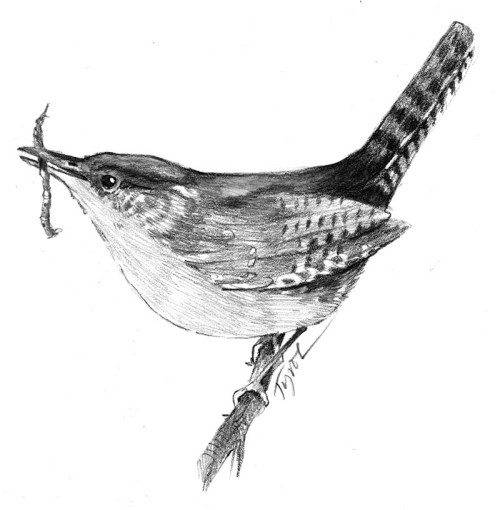
One afternoon in early June, a small brown bird swooped down in front of our kitchen window. I wondered where it had swooped from when, a minute later, I saw it fly back up, with a sliver of straw in its beak. I went out the back door, onto the deck, in time to see the bird exiting the shower vent on the gable end of the house. It was a house wren, and it was building a nest in my house.
Tip to tail, house wrens, Troglodytes aedon, are generally about 5 inches long and weigh about .4 oz. – half the length of the average robin and far lighter. They have brown feathers, longish beaks, and tails that are often tipped upwards. These tiny birds have one of the most expansive breeding ranges of any songbird, stretching from southern areas of Canada, to the far southern reaches of South America. In between they are found across the entire continental United States, the West Indies, Mexico, and Central America.
As a bird lover, I was delighted at the idea of having a family of house wrens just outside the backdoor. My delight was tempered, however, by the fact that my partner Rick and I had spent the past month avoiding the front door, as a pair of robins had built a nest on our front porch. Once all the nestlings fledged, we again felt free to enter and exit our house using either door. At least until the following afternoon, when the house wren showed up.
As cavity-nesting birds, house wrens are often drawn to buildings, with crevices and crannies that suit their nesting needs. The shower vent was ideal, except that it wasn’t designed to stay open. The bottom two flaps happened to be stuck when the wren decide it was a good place to raise a family. Not only were we not interested in restricting our access to the deck or back door, but we worried the bird would find itself unable to get to the nest if the vent suddenly closed.
Still, I didn’t like the idea of interfering with the bird’s efforts. I was already feeling a touch guilty that we’d moved the now-empty robin’s nest to a nearby apple tree, because we didn’t want the pair raising a second brood on the porch, where Rick had some carpentry work to do. My reluctance faded, however, when I learned that the wren was most likely a male constructing a dummy nest – a sort of prototype used to court a potential mate. A single male can construct as many as a dozen, though “construct” may be too an ambitious a word.
“This is not so much to start the nest-building process as it is to psychologically ‘claim’ the space,” explains Scott Johnson, professor of biology at Towson University in Maryland. “When a female arrives on the territory, he often will direct her to one or more of these potential nest cavities by flying between her and the cavities.”
The male will claim the space with nothing more than a few twigs and a bit of white cottony material. When a female chooses one of the offered sites, it is not unusual for the building process to start almost from scratch. “She sometimes will throw out some of the male’s sticks, because they're just too big and hard to work with. Females wisely use smaller, more manageable sticks that can be shaped into a cup,” said Scott.
We decided to check out what was underway in the vent. Rick climbed a ladder and found exactly what Scott described: several twigs and a ball of fuzz. He tossed it into the yard and closed the vent. The wren returned a couple of times that afternoon, but then gave up.
This foreclosure was probably a good thing, because, unlike our resident robins that left the nest at the sight of us, wrens can be tiny terrors when defending their territory. “They will attack nest predators such as chipmunks, weasels and the like, by flying at them, sometimes striking them with their feet. About one in 50 adult males will similarly strike a human in the back of the head when you are looking in their nest box,” said Johnson.
Not only will house wrens attack predators and the occasional human, but the males sometimes destroy the eggs of other birds. “As far as we can tell, this is typically done by unmated males and males whose mate has not yet laid her own eggs,” said Johnson. Once the pair has a clutch to tend, the behavior stops. The usual victims are other cavity-nesting birds that are taking up coveted nesting space. But sometimes male house wrens will attack the eggs of open-nesting species, such as cardinals and robins. “We have no idea why this is done,” said Johnson.
Though they didn’t have the opportunity to take up residence in the vent, a pair of house wrens did settle nearby. We see them flitting around the garden and around the thickets at the edge of the yard. As for the robins, they ignored their displaced nest and built a new one in the exact same spot as the first. Their second clutch had three eggs, and neither we nor the male wren disturbed them.


Discussion *